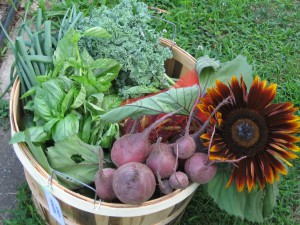I just became a member of a CSA, which stands for Community Supported Agriculture. I first heard the term CSA last Spring, my sister-in-law took me to her “Farm” on pick up day. I thought it was such a great idea and I’m so excited to be able to join a local fa rm.
rm.
CSA Agreements
In the winter and early spring a CSA farm will offer membership shares. The farmers are paid in advance and through the growing season the shareholders receive weekly baskets of produce. The members share the risks and rewards with the farmers.
The Benefits to the Farmers
One of the main benefits to the farmers is receiving working capital to purchase seeds and other supplies in the spring. With the knowledge of how many families they will be supplying produce to, they can plant their crops accordingly. There is less waste, as the farmers do not have to guess what will sell at the farmers market. The farmers are able to spend more time and resources on farming.
The Benefits to the Share Holders
Each week, during the growing season, the CSA members receive a basket of fresh, farm produce, many of the items are harvested the same day the baskets are picked up. The quantity and variety in the baskets will change each week depending on which vegetables are at their peak.
The Benefits to the Environment and Community
Since the farmers are able to sell their vegetables locally the transportation costs are greatly reduced, thus saving on fuel and emissions. The available land can be managed efficiently with the knowledge of the quantity of produce required. The farmers and the members get to meet and form friendships.
I think the CSA is a win, win, win opportunity. I can hardly wait to get my first basket of farm fresh veggies!








![Blueberry_Cluster[1]](https://blog.ketchummfg.com/wp-content/uploads/Blueberry_Cluster1-300x231.jpg)


